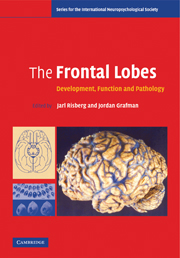Book contents
- Frontmatter
- Contents
- Contributors
- From the series editor
- Introduction
- 1 Evolutionary aspects on the frontal lobes
- 2 Organization of the principal pathways of prefrontal lateral, medial, and orbitofrontal cortices in primates and implications for their collaborative interaction in executive functions
- 3 Human prefrontal cortex: processes and representations
- 4 A microcircuit model of prefrontal functions: ying and yang of reverberatory neurodynamics in cognition
- 5 Prefrontal cortex: typical and atypical development
- 6 Case studies of focal prefrontal lesions in man
- 7 Left prefrontal function and semantic organization during encoding and retrieval in healthy and psychiatric populations
- 8 Clinical symptoms and neuropathology in organic dementing disorders affecting the frontal lobes
- Index
- Plate section
- References
5 - Prefrontal cortex: typical and atypical development
Published online by Cambridge University Press: 11 September 2009
- Frontmatter
- Contents
- Contributors
- From the series editor
- Introduction
- 1 Evolutionary aspects on the frontal lobes
- 2 Organization of the principal pathways of prefrontal lateral, medial, and orbitofrontal cortices in primates and implications for their collaborative interaction in executive functions
- 3 Human prefrontal cortex: processes and representations
- 4 A microcircuit model of prefrontal functions: ying and yang of reverberatory neurodynamics in cognition
- 5 Prefrontal cortex: typical and atypical development
- 6 Case studies of focal prefrontal lesions in man
- 7 Left prefrontal function and semantic organization during encoding and retrieval in healthy and psychiatric populations
- 8 Clinical symptoms and neuropathology in organic dementing disorders affecting the frontal lobes
- Index
- Plate section
- References
Summary
Introduction
The ability to bind the past and the future, to become privileged to the contents of other peoples' minds and to share with them the contents of our own minds, and to use both emotion and thought to guide how we make decisions and what we express socially, all make us uniquely human and able to reflect on our past, our present, our future, our own mind, and others' minds, and to experience emotions and modulate them with thought. In some manner, these abilities are associated with the normal function of the prefrontal cortex.
All cortex in front of the central sulcus is frontal cortex. The primary motor cortex (Brodmann area [BA] 4) is the area in front of the central sulcus (Figure 5.1). The premotor cortex and supplementary motor area (BA 6) lie in front of the primary motor cortex. Everything in front of BA 6 is prefrontal cortex: BA 8, 9, 10, 12, 44, 45, 46, 47, and 9/46. The anterior cingulate gyrus and the posteromedial orbitofrontal cortex are important limbic areas within the prefrontal cortex, and the central frontal lobes also contain the orbitofrontal olfactory area. Functionally, the prefrontal cortex consists of multimodal association cortex, with different architectonic areas having distinct connections with cortical, subcortical, and subtentorial structures (Petrides & Pandya, 2002).
The dorsolateral prefrontal cortex (BA 46 and 9) is above and below the superior frontal sulcus, and is bordered posteriorly by Area 6 and anteriorly by the frontal polar cortex (BA 10).
- Type
- Chapter
- Information
- The Frontal LobesDevelopment, Function and Pathology, pp. 128 - 162Publisher: Cambridge University PressPrint publication year: 2006
References
- 17
- Cited by

